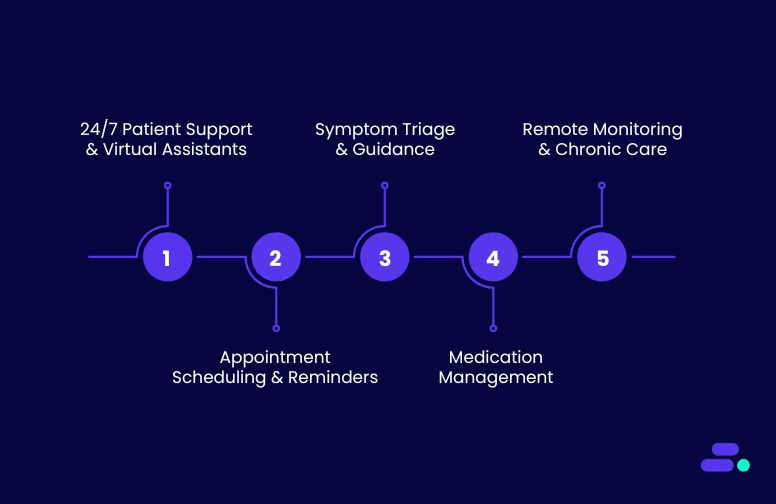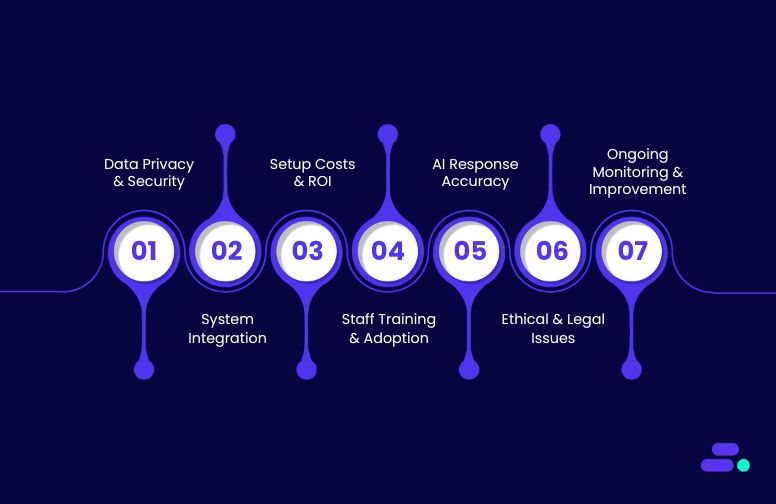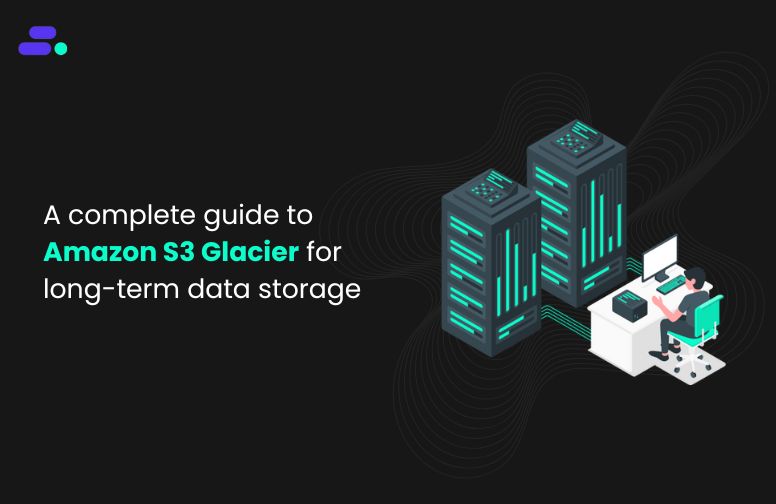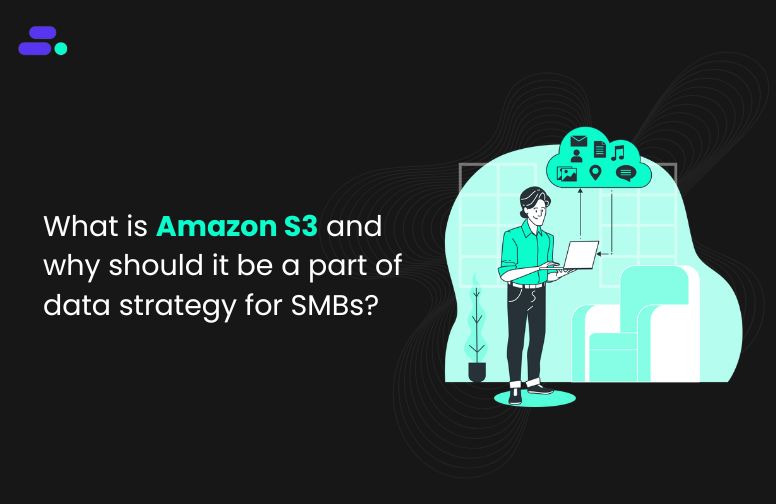This is a div block with a Webflow interaction that will be triggered when the heading is in the view.

Modernize your cloud. Maximize business impact.
Managing complex workflows across multiple AWS services can be difficult to scale and maintain. AWS Step Functions solves this by providing a serverless workflow engine that coordinates tasks into defined, reliable sequences without requiring custom orchestration logic.
For example, a healthcare SMB automating patient onboarding can use Step Functions to chain together Lambda functions for data validation, store records in DynamoDB, run a background verification via API Gateway, and send confirmation emails. They can do all this in a single visual workflow with built-in error handling and retries.
This guide explains how AWS Step Functions work, how to implement them with best practices, and how small and mid-sized businesses can use them to improve automation, reduce complexity, and move faster without sacrificing control.
Key takeaways:
- Step Functions simplify orchestration: They coordinate services like Lambda, S3, Glue, and DynamoDB into reliable, visual workflows, eliminating the need for custom orchestration code.
- Built for complex, scalable automation: Supports both long-running and high-throughput workflows with features like retries, branching, and parallel execution, ideal for modern backend systems.
- Real-world use cases are production-ready: Examples include ETL pipelines, event-driven file processing, multi-branch data merges, and human-in-the-loop approvals, built using actual SMB patterns.
- Deep AWS integration is a core strength: It smoothly integrates with over 220 AWS services, including Amazon Redshift, SNS/SQS, CloudWatch, and RDS, thereby reducing infrastructure overhead and improving consistency.
- Monitoring and debugging are built in: With CloudWatch and X-Ray, teams gain full visibility into the execution flow, performance issues, and error traces, critical for achieving operational excellence.
What is AWS Step Functions?
AWS Step Functions is a fully managed orchestration service that simplifies how teams coordinate distributed workflows across AWS. It utilizes Amazon States Language (ASL) to define processes as state machines, which are JSON-based workflows that link services such as Lambda, S3, DynamoDB, and others.
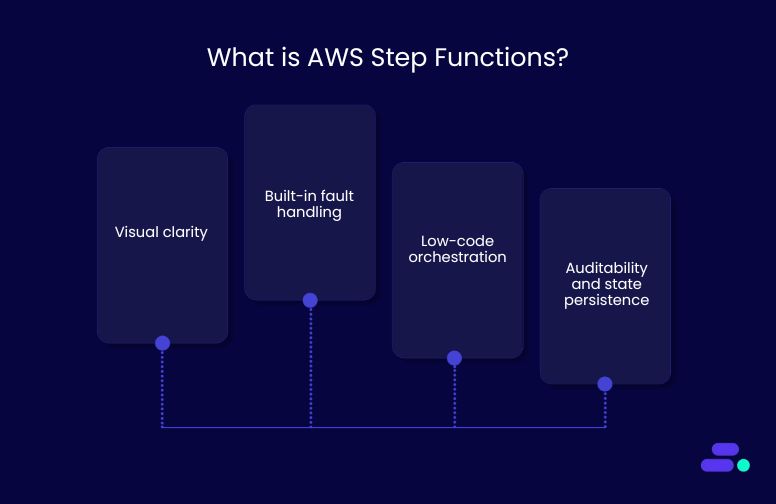
Step Functions brings several advantages to cloud-native architectures:
- Visual clarity: Workflows are represented as state diagrams, making logic easier to understand and debug.
- Built-in fault handling: Automatic retries, catch blocks, and state tracking ensure workflows are resilient to failures.
- Low-code orchestration: Developers focus on business logic while Step Functions handles flow control, error handling, and sequencing.
- Auditability and state persistence: Long-running workflows can pause and resume, while all execution history is recorded for traceability.
The service integrates natively with over 220 AWS services, including Amazon ECS, SageMaker, AWS Glue, and Athena. These native integrations simplify operations such as passing data between services, managing retries and exceptions, and handling authentication, all without custom glue code.
Whether coordinating high-volume data processing tasks or managing approval flows in business processes, Step Functions offers a scalable, reliable foundation for building event-driven and serverless applications on AWS.

Implementing AWS Step Functions: a step-by-step guide
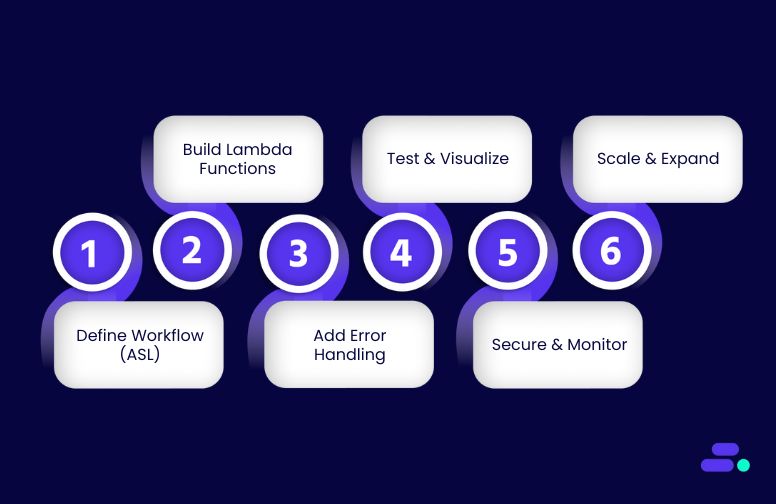
For SMBs looking to automate processes without overcomplicating infrastructure, AWS Step Functions offers a practical and scalable solution. This service helps coordinate tasks across AWS, allowing technical teams to focus on business value instead of operational plumbing.
To understand how it works, consider a familiar scenario of a healthcare center automating a patient intake and scheduling workflow using AWS Step Functions. The workflow includes:
- Accept patient registration
- Verify insurance details
- Check provider availability
- Schedule appointment
- Send a confirmation email
Each step is orchestrated by AWS Step Functions, using services like AWS Lambda, Amazon DynamoDB, and Amazon SES.
Step 1: Define the workflow using Amazon States Language (ASL)
The first step is defining a state machine using Amazon States Language (ASL). Each “state” maps to a task in the intake process.
Example ASL definition:
{
"StartAt": "VerifyInsurance",
"States": {
"VerifyInsurance": {
"Type": "Task",
"Resource": "arn:aws:lambda:region:acct:function:VerifyInsurance",
"Next": "CheckAvailability"
},
"CheckAvailability": {
"Type": "Task",
"Resource": "arn:aws:lambda:region:acct:function:CheckAvailability",
"Next": "ScheduleAppointment"
},
"ScheduleAppointment": {
"Type": "Task",
"Resource": "arn:aws:lambda:region:acct:function:ScheduleAppointment",
"Next": "SendConfirmation"
},
"SendConfirmation": {
"Type": "Task",
"Resource": "arn:aws:lambda:region:acct:function:SendEmail",
"End": true
}
}
}What this code does: This JSON defines an AWS Step Functions state machine that automates a patient appointment workflow. It specifies a sequence of tasks, each linked to an AWS Lambda function:
- StartAt: "VerifyInsurance": The workflow begins by verifying the patient’s insurance.
- "VerifyInsurance": Calls a Lambda function to validate insurance, then moves to check provider availability.
- "CheckAvailability": Queries available appointment slots.
- "ScheduleAppointment": Books the appointment in the system.
- "SendConfirmation": Sends a confirmation email to the patient and ends the workflow.
Each state is a step in the process, and the Next or End fields control the execution flow. This enables a fully automated, fault-tolerant healthcare intake process.
Step 2: Build the supporting AWS Lambda functions
Once the workflow is defined in Step Functions, each state must be backed by a purpose-built AWS Lambda function that executes a specific task in the sequence. These functions contain the actual business logic, whether it’s checking insurance, querying appointment slots, or sending emails. They are triggered automatically as the state machine progresses.
Each function should be:
- Modular and independently testable
- Scoped with minimal IAM permissions
- Configured with timeouts and retries based on expected SLA
This separation of concerns ensures each task is easy to manage, secure, and scalable, allowing healthcare teams to update or extend individual steps without disrupting the entire process.
Example Lambda (Node.js) for insurance verification:
exports.handler = async (event) => {
const isValid = await checkInsuranceAPI(event.insuranceId);
if (!isValid) throw new Error("Insurance verification failed");
return { status: "verified" };
};Here:
- event.insuranceId: Receives the insurance ID from the Step Functions input.
- checkInsuranceAPI(...): Calls an asynchronous function to verify insurance status with an external system.
- Error Handling: If the insurance is not valid, the function throws an error. Step Functions can catch this and route to an error state.
- Return: If the insurance is verified, it returns a success status for the next step in the workflow.
This function typically powers the VerifyInsurance state in a healthcare appointment scheduling workflow.
Step 3: Add error handling and retries
Healthcare workflows require fault tolerance. Step Functions provides native retry and catch mechanisms.
Example retry config for insurance check:
"VerifyInsurance": {
"Type": "Task",
"Resource": "arn:aws:lambda:...:VerifyInsurance",
"Retry": [
{
"ErrorEquals": ["Lambda.ServiceException"],
"IntervalSeconds": 5,
"MaxAttempts": 3
}
],
"Catch": [
{
"ErrorEquals": ["States.ALL"],
"Next": "LogFailure"
}
],
"Next": "CheckAvailability"
}Here:
- Type: "Task": This is a state that runs a task. In this case, a Lambda function.
- Resource: The ARN of the Lambda function VerifyInsurance, which handles insurance validation.
- Retry block: Retries up to 3 times if the Lambda returns a Lambda.ServiceException (a common transient error). Waits 5 seconds between each retry.
- Catch block: Catches all types of errors (States.ALL) if retries fail. Redirects the flow to a fallback state called LogFailure, which could handle logging, alerting, or compensation.
- Next: If the Lambda succeeds, the flow continues to CheckAvailability.
This setup ensures resilience and error visibility. If the insurance verification step temporarily fails (e.g., due to network latency), retries handle it automatically. If the failure is persistent, it is safely caught and redirected, preventing silent workflow failures.
Step 4: Visualize and test the workflow
Once the state machine is defined and deployed, the AWS Step Functions visual workflow console provides a clear, interactive way to test and monitor it, making it valuable for both technical and non-technical stakeholders.
The visual interface shows the full execution path of the workflow, step by step. This allows teams to see how data moves, where errors may occur, and what the outputs are at each stage. It also helps stakeholders like clinic administrators understand and verify the business logic before deploying to production.
Key benefits of the visual console:
- Real-time execution tracking: Each state is highlighted as it executes, providing instant visibility into progress and outcomes.
- Step-level inspection: Click into each state to view input/output data, runtime metrics, and any errors, ideal for debugging.
- Test case simulation: Teams can run test inputs (e.g., invalid insurance ID, unavailable appointment slots) to validate error handling and fallback logic.
- Cross-functional clarity: Non-developers can follow the workflow visually, making collaboration across technical and business teams easier.
This step ensures the workflow is functioning as intended, reduces the risk of bugs post-deployment, and builds team confidence in the automation.
Step 5: Secure and monitor the workflow
In healthcare scenarios, especially those involving sensitive patient data, security and observability are non-negotiable. AWS Step Functions, combined with supporting AWS services, allows SMBs to build workflows that are secure, compliant (e.g., with HIPAA), and fully traceable.
To ensure that every step of the workflow is both protected and observable, it’s important to implement the following:
Security best practices:
- Use least-privilege IAM roles: Assign narrowly scoped roles to each Lambda function and the Step Function itself. This limits what resources each service can access, minimizing risk if credentials are compromised.
- Encrypt environment variables and outputs: Ensure sensitive data (like patient IDs or insurance info) is encrypted in transit and at rest using AWS KMS.
Monitoring and observability:
- Enable CloudWatch Logs: Log all execution data, including inputs, outputs, errors, and durations. These logs are essential for debugging and post-incident analysis.
- Set CloudWatch Alarms: Trigger alerts for failed states, such as an unverified insurance policy or a scheduling failure, so the ops team can respond immediately.
- Enable AWS X-Ray (optional): For more complex workflows, X-Ray traces end-to-end execution across services like Lambda, API Gateway, or DynamoDB, helping diagnose latency and bottlenecks.
By integrating these tools, SMBs get enterprise-grade monitoring and security without needing costly third-party solutions. This foundation supports both trust and reliability in healthcare workflows.
Step 6: Scale and expand
As the healthcare SMB grows, adding new providers, locations, or services, the appointment scheduling workflow must evolve to handle increased complexity without creating new technical debt. AWS Step Functions is designed with modularity and scalability in mind, allowing teams to enhance their workflows incrementally.
Ways to expand the workflow:
- Parallel states: Support multiple provider checks at the same time (e.g., when a patient can see any available doctor across departments).
- Choice states: Route logic based on insurance type, appointment urgency, or patient age group. For example, directing pediatric appointments to specific providers.
- Map states: Handle batch processes like sending follow-up reminders for multiple patients, processing appointment cancellations in bulk, or reconfirming bookings.
Why this matters: Step Functions allows SMBs to scale without rewrites. As regulations, services, or team sizes change, businesses can plug in new functionality with minimal disruption. This adaptability is especially valuable in healthcare, where patient care, compliance, and system reliability must go hand in hand.
Final outcome: What does the SMB get out of AWS Step Functions?
Using AWS Step Functions to automate appointment scheduling allows the healthcare SMB to transform a fragmented intake process into a coordinated, reliable workflow. The result is:
- Streamlined operations: Tasks like insurance checks, scheduling, and notifications run seamlessly without manual coordination.
- Faster patient onboarding: Real-time validation and booking reduce delays for both patients and staff.
- Lower operational overhead: Staff spend less time chasing paperwork or managing schedules, freeing up time for patient-facing activities.
- Built-in adaptability: New services, insurers, or routing rules can be added with minimal changes to existing logic.
The overall impact is greater efficiency, fewer errors, and a foundation that supports both patient satisfaction and long-term business growth.

AWS Step Functions: popular use cases and examples
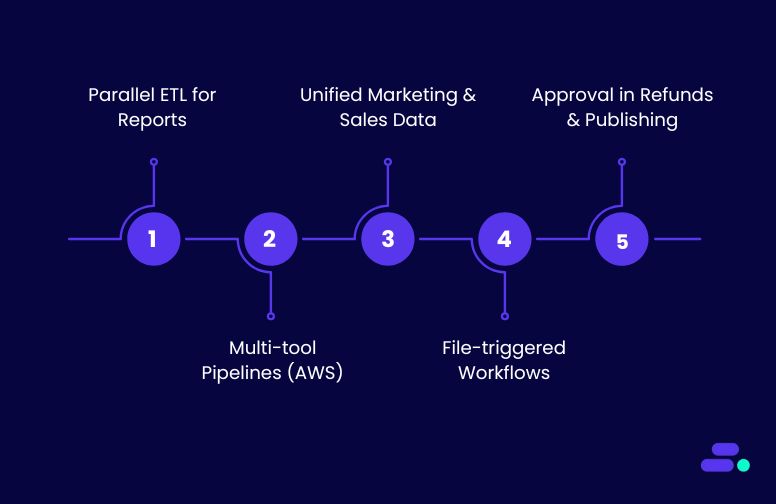
SMBs with limited DevOps resources but growing backend complexity, such as healthcare providers, fintech startups, SaaS vendors, and e-commerce businesses, benefit most from AWS Step Functions. These organizations need to automate multi-step processes like appointment scheduling, transaction validation, or order fulfillment across several AWS services without building and maintaining brittle glue code.
Built-in retries, state tracking, and visual debugging make it easier to deliver consistent outcomes, handle failures gracefully, and meet compliance or SLA requirements. With AWS Step Functions, SMBs can implement resilient, observable workflows with minimal operational overhead.
1. Parallel ETL processing for daily business reports
The challenge: A retail SMB needed to process product, transaction, and user data nightly for business dashboards. Running ETL tasks one after another created delays and missed report deadlines.
How AWS Step Functions helped: Using a Parallel state, AWS Step Functions ran three AWS Glue jobs simultaneously:
- Product data was validated and standardized.
- Transactions were deduplicated and enriched.
- User logs were normalized by timestamp.
If any job failed, the error was logged in AWS DynamoDB, and an alert was sent through Amazon SNS. Successful outputs were merged and loaded into Amazon Redshift.
Outcome: Faster pipeline execution, reduced latency, and consistent daily insights, all without manual coordination.
2. Multi-tool data pipelines using AWS
The challenge: A fintech client processed various datasets using different tools—AWS Glue for cleaning, Amazon EMR for heavy compute, and Amazon Athena for querying—but lacked orchestration across services.
How Step Functions helped: The workflow used a Choice state to inspect file schema and trigger the correct tool:
- Schema A → Glue job
- Schema B → EMR cluster with PySpark
After processing, Athena ran a validation query. Based on results, data was marked complete in DynamoDB or rerouted for reprocessing.
Outcome: One orchestrated pipeline with tool-specific optimization, improving SLAs and eliminating manual triggers.
3. Unified marketing + sales data for executive reporting
The challenge: Marketing and sales teams processed data in silos, leading to inconsistent metrics. Leadership needed a unified view for campaign ROI.
How Step Functions helped: A Parallel state launched:
- A Glue job for ad campaign metadata
- A Lambda chain for sales transactions and currency normalization
Both outputs were stored in Amazon S3 and joined using a Lambda function keyed on campaign IDs. Final results were written to Amazon Redshift.
Outcome: Consistent, near-real-time insights across departments with reduced manual data merging.
4. File-triggered workflows with conditional routing
The challenge: A logistics SMB received daily files (orders, inventory, returns) via Amazon S3, but handled each manually. Errors and delays were common.
How Step Functions helped: S3 event notifications triggered a Lambda function that parsed file metadata. A Choice state then routed:
- “Orders” → Glue job
- “Inventory” → Lambda formatter
- Unknown files → Archive + alert via SNS
Each processing path included success checks and stored results in partitioned S3 folders.
Outcome: Fully automated, reliable workflows triggered by file uploads with dynamic routing logic.
5. Human approval in refund and publishing workflows
The challenge: A healthcare SMB needed human approval for certain actions like patient record updates and issuing refunds while keeping automation intact.
How Step Functions helped: The workflow paused using task tokens after an automated refund eligibility check.
A reviewer received an approval link via email. Based on their decision:
- Approved → credit issued
- Rejected → action logged and archived
Timeouts ensured no indefinite waiting; escalations triggered if no response came in.
Outcome: Built-in compliance, traceability, and secure human input within a fully automated backend.

With the help of AWS partners like Cloudtech, SMBs can quickly integrate AWS Step Functions into their existing workflows. Their deep AWS expertise and an SMB-first approach helps design, implement, and optimize step-based automation tailored to business needs.
How does Cloudtech implement AWS Step Functions for scalable business workflows?
Cloudtech helps small and mid-sized businesses build production-grade orchestration systems using AWS Step Functions, enabling secure and scalable automation of backend workflows. As an AWS Advanced Tier Services Partner, it provides full lifecycle implementation with deep integration into AWS-native services, robust security, and long-term support.
Key areas of implementation include:
- Data modernization: Cloudtech uses AWS Glue, Amazon S3, and Amazon Redshift to coordinate data ingestion, transformation, and governed storage. Workflows include built-in alerting with Amazon CloudWatch and Amazon SNS, and audit visibility using AWS CloudTrail.
- Serverless backend orchestration: Cloudtech decouples application logic using AWS Lambda and AWS Step Functions to handle conditional flows, retries, and external service calls, creating maintainable, scalable systems that replace legacy scripts or hardcoded integrations.
Every deployment includes secure IAM configuration, AWS Key Management Service (AWS KMS) encryption, and optional use of AWS Secrets Manager for sensitive data handling. Monitoring and debugging are set up using Amazon CloudWatch Logs, CloudWatch Metrics, and AWS X-Ray.
For SMBs transitioning to cloud-native operations or expanding existing AWS usage, Cloudtech offers deep Step Functions expertise and operational rigor to accelerate implementation and maximize ROI.

Conclusion
AWS Step Functions bring structure and resilience to complex cloud workflows, making it easier for small and mid-sized businesses to automate operations without sacrificing control. By managing retries, branching logic, and service coordination in one place, they eliminate the need for brittle scripts or manual handoffs.
Cloudtech uses AWS Step Functions to turn scattered cloud tasks into unified, production-grade systems, whether it's automating patient intake in healthcare or orchestrating ETL pipelines in finance. Each implementation is optimized for cost, security, and long-term maintainability, tailored to the business’s specific cloud maturity and growth goals.
Reach out to us for implementation support and architecture aligned with AWS best practices.
FAQ’s
1. What are the Step Functions in AWS?
AWS Step Functions is a serverless orchestration service that connects AWS components into workflows. It utilizes visual state machines to manage execution flow, error handling, and parallel tasks, thereby automating and controlling backend processes at scale.
2. What are the types of Step Functions in AWS?
AWS offers Standard and Express workflows. Standard supports long-running, durable processes with full execution history, while Express is optimized for short-lived, high-volume tasks that require fast throughput and cost-efficient execution.
3. What are some of the applications of AWS Step Functions?
Step Functions are used for ETL pipelines, file-driven workflows, modular backends, approval flows, and distributed data processing. They support event-based automation and coordinate services like Lambda, Glue, DynamoDB, and SNS with built-in observability.
4. What is the difference between AWS Lambda and AWS Step Functions?
Lambda executes individual functions, while Step Functions coordinates multiple functions and services into structured workflows. Step Functions manage sequencing, retries, and branching across steps, whereas Lambda focuses on executing single tasks.
5. Is AWS Step Functions similar to Azure?
AWS Step Functions is similar to Azure Durable Functions. Both offer orchestration of serverless tasks using stateful workflows, allowing developers to manage dependencies, parallelism, and retries without writing complex coordination code.

Get started on your cloud modernization journey today!
Let Cloudtech build a modern AWS infrastructure that’s right for your business.

